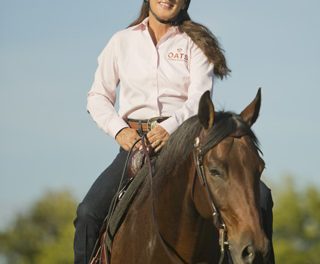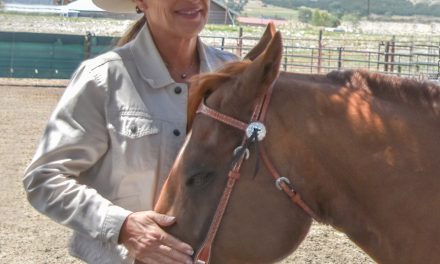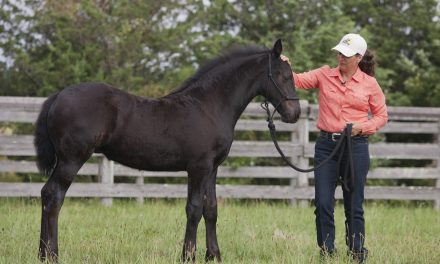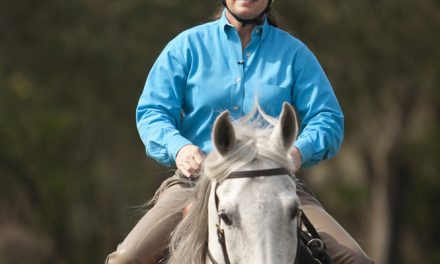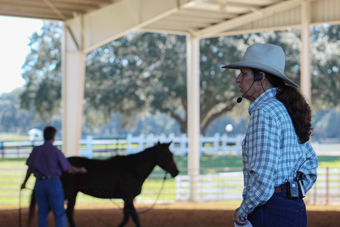
Riding Right
I have a question regarding using one rein, versus two, while riding and stopping your horse. When I ride with two hands or use the one-rein stop on my horses, it seems to calm them and refocus their attention. Can you help explain why direct rein pressure seems to be so effective?
Thanks,
Two-handed
Dear Two-handed,
Any horse will work better when the reins are used one at a time or with alternating pressure as opposed to applying pressure to both reins at the same time. There are several reasons for this and all have to do with the horse’s comfort.
First, when you pull on both reins at the same time, it causes a horse to clench his jaw, stiffen his neck and lean into the pressure. It also puts constricting pressure on his tongue, making it impossible for him to swallow and gives him a choking sensation; this will cause him to lift his head and hollow in the neck and back.
Secondly, using both reins at once puts you and your horse in a tug-of-war with you that he will always win because he out weighs you by so much. In a sense, it gives the horse something to lean on or brace against.
We want our horses to stay soft in the jaw and relaxed in the neck with his topline slightly rounded. That will only happen when you use one rein at a time. The mechanics of the bit are such that when you pull on both reins at the same time, it creates pressure all over his mouth, jaw and palate; clamping his tongue down.
It is too much pressure and the horse’s only concern will be to get away from the pressure however he can. You also lose any ability to be articulate with the rein aids and use the reins to influence certain parts of his body, because the pressure is everywhere and is relentless.
Even in a hackamore, rope halter, side-pull, etc., you’ll get the same response if you pull on both reins at the same time and statically. It simply gives the horse something to brace against and lean on. He cannot lean one rein because it focalizes the pressure and keeps his neck bent instead of poking out straight.
You’ll always have more control over the horse when his neck is slightly bent than when it is straight. It is when the horse stiffens his neck straight in front of him with his jaw clenched that we lose control.
Using one rein to stop or using both reins alternately for collection is the ideal. Even when using both reins, you always want to keep a rhythm in the reins so that you are not pulling on both reins at the same time—this rhythm should match the movement of the horse’s hind legs.
There is a well-documented behavior that I think helps explain why horses are more responsive to one rein than two. When a horse eats or drinks (from the ground) he is very vulnerable because his vision is so poor at that point that he can only see the ground immediately around him. Therefore, when a horse eats or drinks (in the wild) he will eat a few bites, slowly lift his head, swing it to one side, go back down for another few bites, lift his head, slowly swing it to the other side. It is theorized that this is an instinctive behavior of horses that helps keep them safe from predators when their head would other wise be down in that vulnerable position. Therefore, if we can move a horse’s nose from side to side and keep his neck loose and relaxed, he stays soft and calm.
When a person pulls relentlessly on both reins in an attempt to bring the horse into control or to get him to come on the bit (something I see everywhere I go) it tends to lead to the horse getting more and more out of control and agitated until he begins to “run through the bridle” in an attempt to escape the confusing, painful and relentless pressure on his mouth. The more you pull back, the faster the horse goes.
It is hard for people to grasp that they need to release the pressure before they can get the horse to stop or be responsive at all. Using the one-rein stop, you’ll never have this problem, even if your release is not as good as it should be. By and large, the biggest problem that people have riding is not releasing the horse from bit pressure enough.
Finally, using the one rein stop will lead to a disengagement of the hindquarters (disengagement occurs when the horse crosses his hind legs) which will always cause the horse to calm down, focus on you and accept your authority. Again, this is a natural behavior of horses but one that is only seen in neo-natal foals (foals under one month of age). If the mother disciplines the foal, he will sometimes drop his head and cross his hind legs in contrition.
When a horse crosses his hind legs it takes away his flight response, leaving him in a more cooperative mood. When you lift up one rein toward your belly button or opposite shoulder, it causes the horse to disengage as he stops. As soon as you feel the horse’s back bend as his hip comes under you (it is a very distinctive feel) you release the rein entirely. With practice, a slight lift of one rein will cause the horse to stop.
We use disengagement any time we lose a horse’s attention or anytime he becomes nervous or fractious—from the ground or from the saddle. We use the one rein stop on young horses or any horses that are very forward and/or resistant to pressure from the reins. The finished horses stop off your seat, without any rein pressure at all. Disengagement and the one-rein stop are generally techniques that you can use on any horse at any time.
For a wealth of information on this and many other topics and to purchase educational videos and training equipment, visit my website, http://www.juliegoodnight.com.
Coming Next:
Julie Goodnight reveals the scenarios and answers she’s asked to help with most often. Goodnight will help you understand why your horse does what he does and give you step-by-step directions to help you solve the problem. Watch “Horse Master” with Julie Goodnight on RFD-TV every Wednesday at 5:30p EST —Direct TV channel 379, Dish Network channel 231 or 9398 or catch clips online at juliegoodnight.com or youtube.com/juliegoodnight. JG

